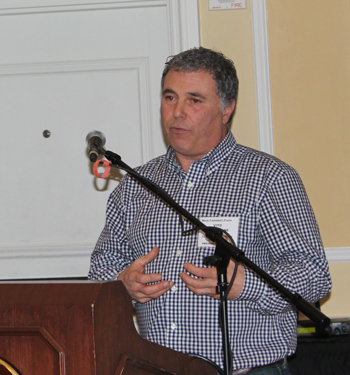Cod Extinction Unlikely
continued from Homepage

Giacalone said the problem is not with the models, but with the data, particularly given the fraction of ocean covered by the federal trawl survey. “It’s not about whether they’re going in the right place or not. It’s about how much sampling occurs,” he said, citing “a hundredth of a percent” of swept area sampled for 20 minutes once a year.
“Even at these high fishing mortalities, cod is still sustainable,” he said. “It’s far from optimal. We’re not getting as much yield out of cod as we can. But we really need to take extinction and unsustainability off the table as far as arguments go. What we should be doing is managing toward optimum yield.”
Cadrin said efforts to rebuild Gulf of Maine cod have been hampered by a disconnect between data and the models used to interpret the data.“What we need to remind ourselves is, data are real. Either a fisherman held that fish, or a scientist observed those fish on deck. If the data don’t agree with the model, I would question the model, rather than question the data,” Cadrin said. “These models have a lot of subjective decisions, and for some of these decisions there’s no clear right or wrong and there are valid alternatives for each.”
At the same time, he said, the information available from fishery surveys is often too noisy to draw conclusions that will help inform management decisions.
“Cod fishermen have been asking me for years, ‘Are the low stock sizes the result of not allowing us to catch many fish? ‘My default answer is, ‘A good stock assessment should be able to tell the difference.’ If you have good surveys, they should be able to tell if that low catch is from low fishing mortality or from a low stock size. I conclude our current surveys have too few stations that are not fishing around the year enough to tell whether low catches are coming from a low population size or from low fishing mortality.”
The most recent Gulf of Maine cod assessment said that overfishing is occurring, the stock is overfished, and the stock cannot meet rebuilding objectives even with no fishing.
“But that doesn’t mean there’s any threat of extinction,” Cadrin said. He continued, “The crisis is not a result of irresponsible management or excessive fishing. The managers have followed the scientific advice. The fishermen have stayed within their catch limits. You hear these terms ‘overfishing,’ ‘overfished,’ and it implies the fishermen have been the cause of the problem. If we’re looking for cause, it’s scientific uncertainty. We haven’t updated the assessment frequently enough. There have been abrupt changes in perception. We have arbitrarily rapid expectations of rebuilding and arbitrarily high rebuilding targets.”
Cadrin urged further scrutiny of the science.
“I don’t think we should be shutting down fisheries until we uncover every rock in our assessment and make sure we’re getting it right,” he said. “But we also need to scrutinize the assessment to identify the problems and develop solutions. One of the primary problems is, with such low catch, we need better survey information.”
Cadrin advocated for more survey stations throughout the year sampling all cod habitat.
But until the science has improved, he said, managers and fishermen need to come up with solutions to deal with the current decisions being made. Sectors have been in the throes of trying to sustain their fisheries, but because of limits on codfishing, have only been able to catch about 30 percent of the total groundfish allocation.
“There’s so much multispecies not being caught,” he said. “How can the fleet catch more of that allocation while staying within the limits? Those are the solutions we need work on together.”
“More and more fishermen are scared to death about being able to harvest their other stocks,” said Vito Giacalone, chair of governmental affairs for the Northeast Seafood Coalition. “When we’re at such a low level, as we are with Gulf of Maine cod right now, it is less of an economic factor where the industry is trying to land more cod, because the difference between 500 tons and 1,000 tons isn’t whether you have a cod fishery or don’t have a cod fishery. It’s whether you go to work and catch other stocks or not.”
Giacalone said the problem is not with the models, but with the data, particularly given the fraction of ocean covered by the federal trawl survey. “It’s not about whether they’re going in the right place or not. It’s about how much sampling occurs,” he said, citing “a hundredth of a percent” of swept area sampled for 20 minutes once a year. The survey is inadequate given the complex bottom geography, complex species, and additional factors such as feed and changing water conditions.
“It seems to me it’s an incredible crapshoot to try to divine relative abundance only from the trawl survey,” Giacalone said. “There’s a lot of stuff we can get out of the survey that we can’t get out of something else, but we need another way to look at whether the trawl survey is giving us the right relative abundance or is it a good true abundance index.”
Giacalone advocated for better use of fishery-dependent data in the assessment.
But Michael Palmer, an assessment scientist with the Northeast Fisheries Science Center, said the assessment model does use fishery data.
“One of the bigger signals we see is truncation of size and age structure, both in the commercial and recreational fisheries,” Palmer said. “Over the last decade, especially in the last five years, we’ve had very poor recruitment of Gulf of Maine cod. There are consistent indications the Gulf of Maine cod population is in poor condition.”
